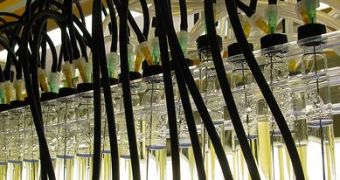The industrial production of algae biofuel would be feasible within the next 15 years, say two researchers from Wageningen UR (University & Research center) in their article published today in Science.
Professor René Wijffels and Dr Maria Barbosa of Wageningen UR say in their article An Outlook on Microalgal Biofuels that Europe could become independent of fossil fuels if it starts producing microscopically small algae in bulk in large-scale installations.
In order for algae to be cultivated industrially, nitrogen and phosphates could be extracted from manure and wastewater, carbon dioxide would come from industrial residues and with sunlight as source of energy, all requirements are met.
As seawater can be used for algal cultivation, this process will provide not only biofuel, but also proteins and oxygen, and it will all be technologically possible within 10 to 15 years, as production scale should be multiplied by three and production costs reduced by 90%.
According to scientists' calculations of energy needs in transportation in Europe, around 0.4 billion m3 biodiesel would be necessary to replace all transport fuels and 9.25 million hectares of land would be needed to grow the micro-algae, assuming a production of 40,000 liters of biodiesel per hectare supplies the European market.
Because algae produce the maximum quantity of oily substances under stress, they are much more efficient that crops like oilseed rape, and they do not even need full sunshine for cultivation.
By using reactors that look like vertical plates, onto which the light shines from one side, it would be possible to produce 20-80,000 liters of oil per hectare.
The only problem that remains is the price, actually of €250/kg, for the 5000 tonnes of algae produced annually in the entire world.
Algae are expensive because they can produce rare substances like carotenoids and omega 3 fatty acids that are used in food supplements.
In order for the price of algae to reach palm oil costs of €0.50 /kg or even less, residues such as wastewater and CO2 from exhaust gases must be used, the technology needs improvement and the production should be moved to sunnier countries.
Even so, for the production to be viable financially, the whole algal biomass of 50% oil, 40% proteins and 10% sugars must be used.
Another good thing about algae is that crops would not interfere with food production, and if all transport fuels would be replaced with algal oil in Europe, 0.3 billion tons of proteins would become available as well.

 14 DAY TRIAL //
14 DAY TRIAL //